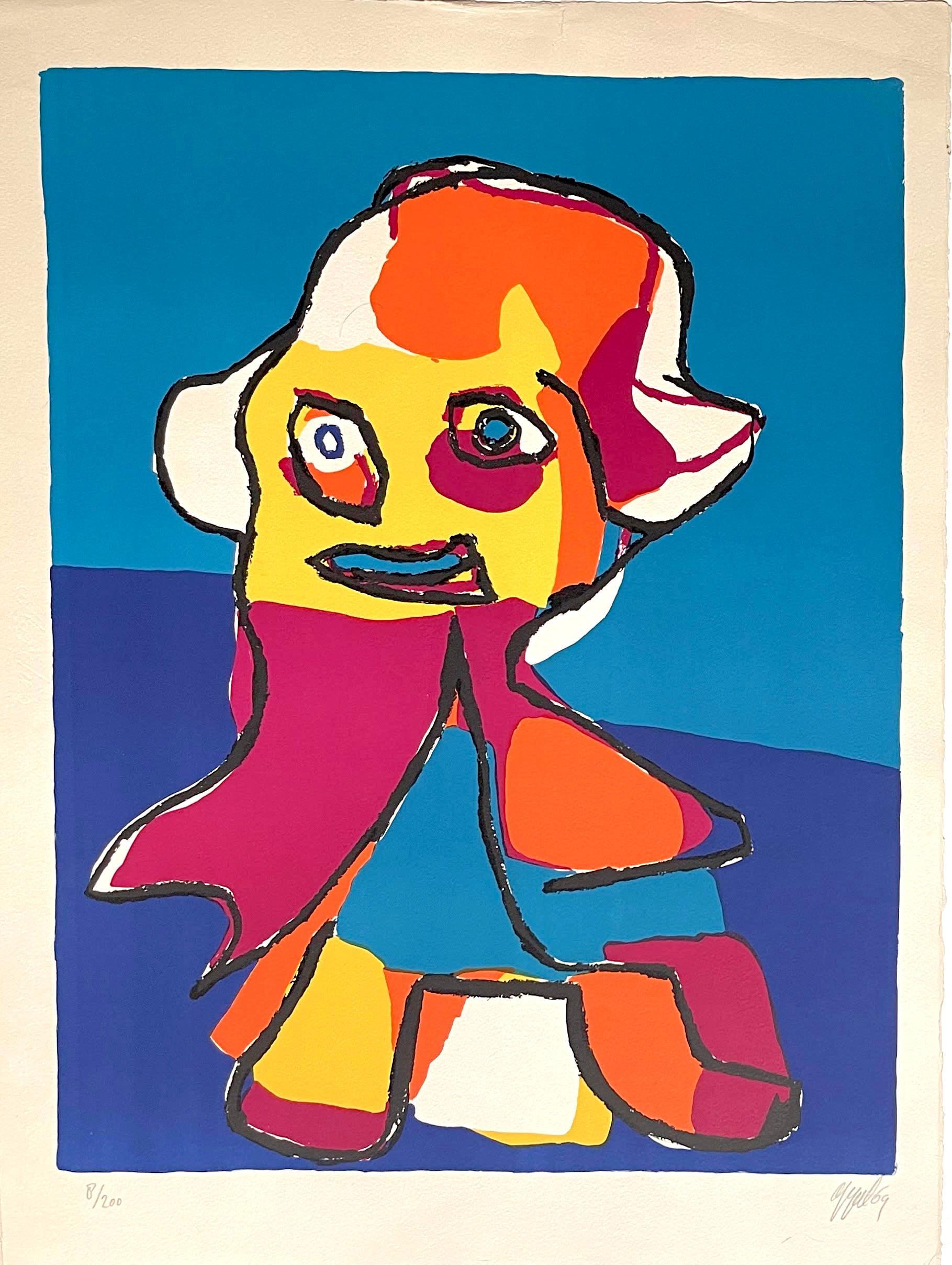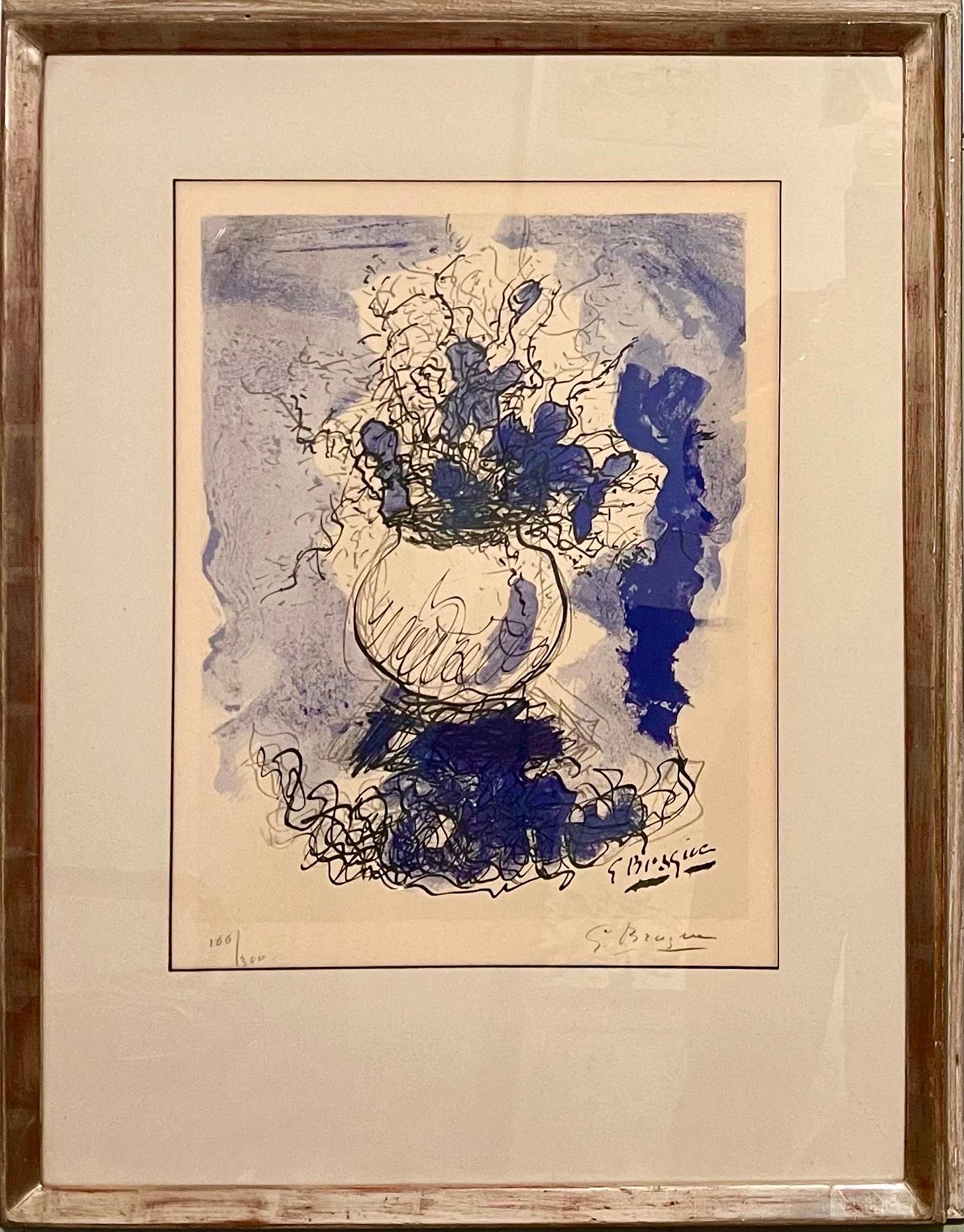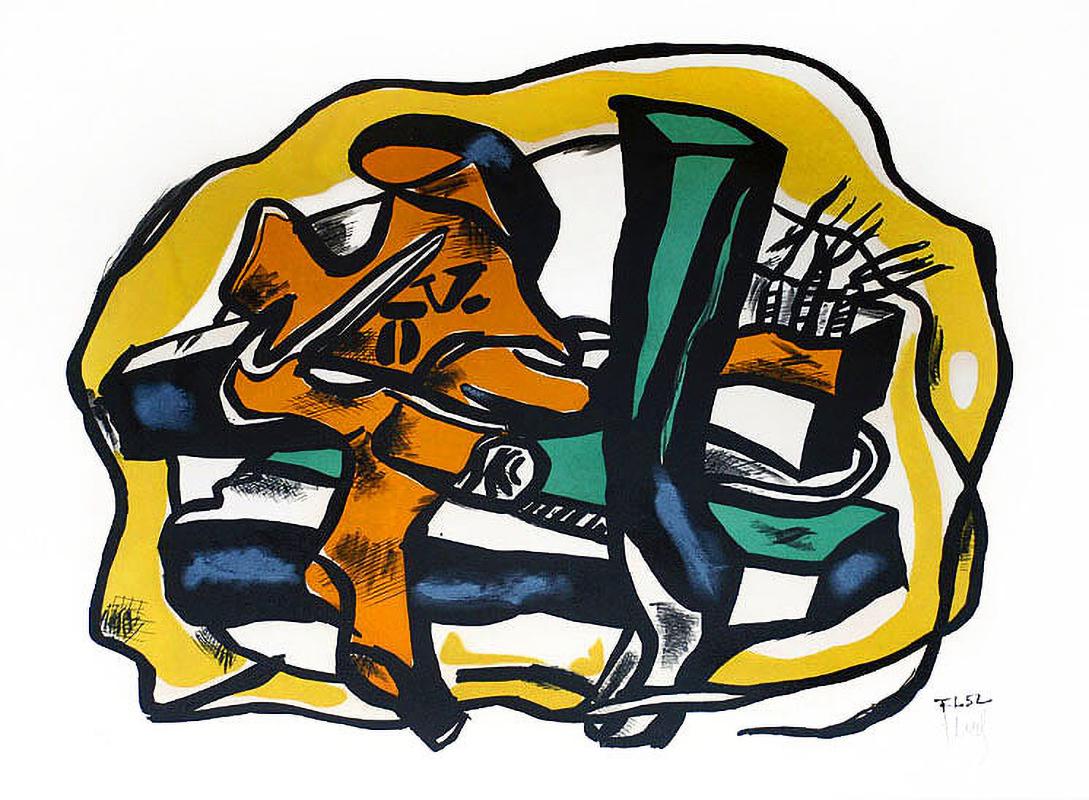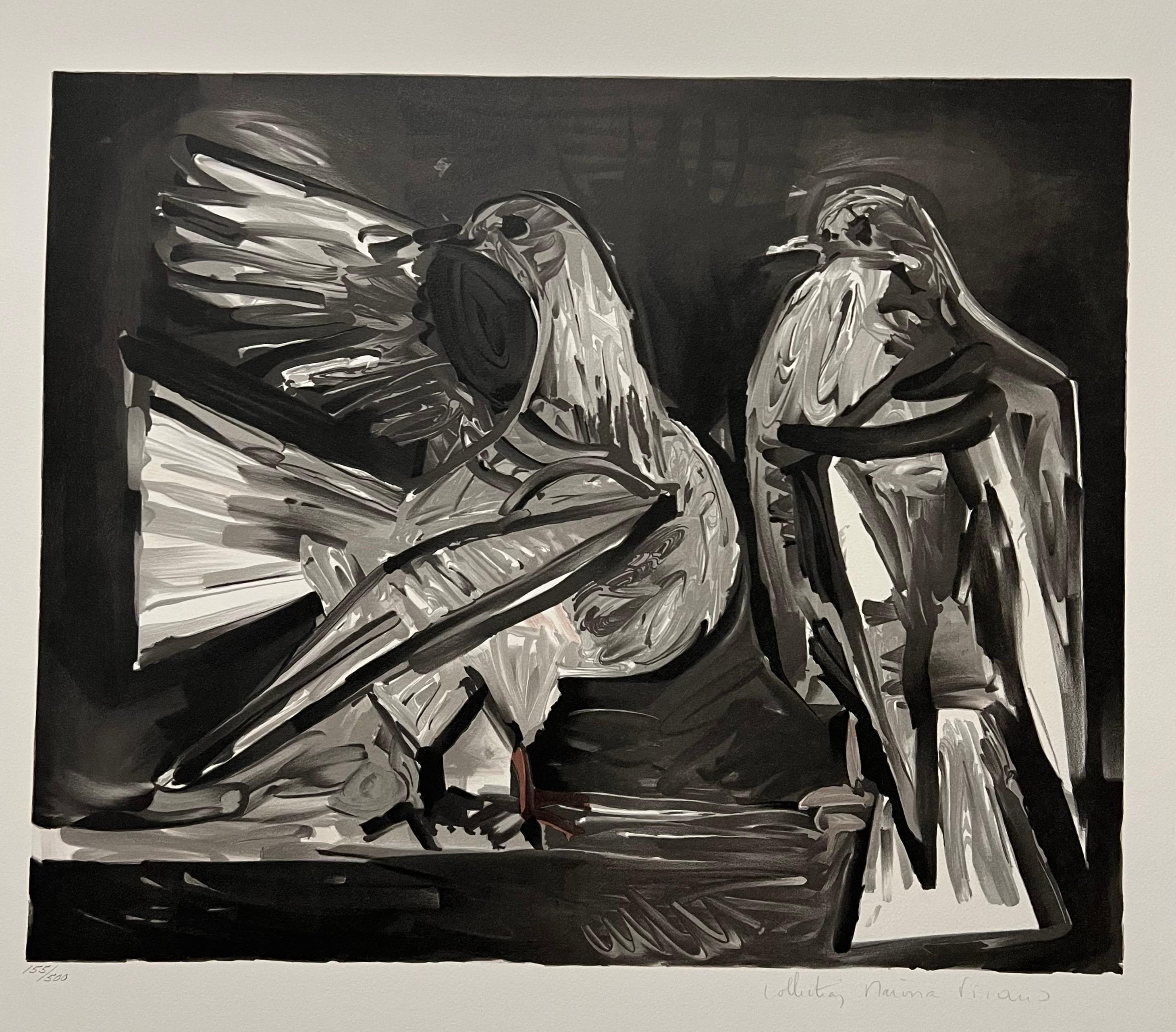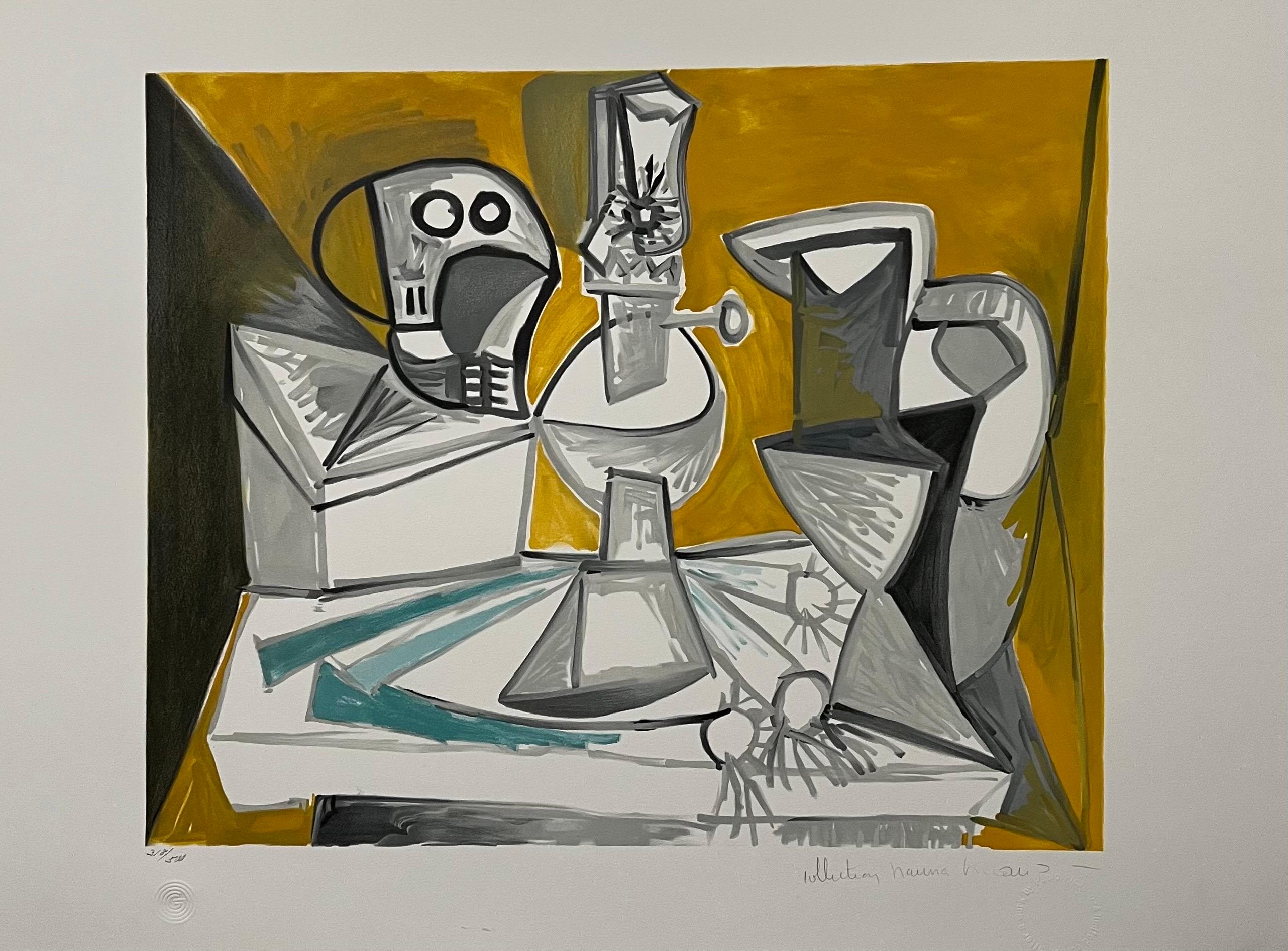Items Similar to After Pablo Picasso - Wildlife of Antibes - Lithograph
Want more images or videos?
Request additional images or videos from the seller
1 of 11
UnknownAfter Pablo Picasso - Wildlife of Antibes - Lithograph1959
1959
About the Item
After Pablo PICASSO (1881-1973)
One plate from the book: Jaime Sabartés. "Faunes et flore d'Antibes" (Greenwich, Conn: New York Graphic Society, 1960).
Color Lithograph
63 x 47 cm
Picasso is not just a man and his work. Picasso is always a legend, indeed almost a myth. In the public view he has long since been the personification of genius in modern art. Picasso is an idol, one of those rare creatures who act as crucibles in which the diverse and often chaotic phenomena of culture are focused, who seem to body forth the artistic life of their age in one person. The same thing happens in politics, science, sport. And it happens in art.
Early life
Born in Malaga, Spain, in October of 1881, he was the first child born in the family. His father worked as an artist, and was also a professor at the school of fine arts; he also worked as a curator for the museum in Malaga. Pablo Picasso studied under his father for one year, then went to the Academy of Arts for one year, prior to moving to Paris. In 1901 he went to Paris, which he found as the ideal place to practice new styles, and experiment with a variety of art forms. It was during these initial visits, which he began his work in surrealism and cubism style, which he was the founder of, and created many distinct pieces which were influenced by these art forms.
Updates in style
During his stay in Paris, Pablo Picasso was constantly updating his style; he did work from the blue period, the rose period, African influenced style, to cubism, surrealism, and realism. Not only did he master these styles, he was a pioneer in each of these movements, and influenced the styles to follow throughout the 20th century, from the initial works he created. In addition to the styles he introduced to the art world, he also worked through the many different styles which appeared, while working in Paris. Not only did he continually improve his style, and the works he created, he is well known because of the fact that he had the ability to create in any style which was prominent during the time.
Russian ballet
In 1917, Pablo Picasso joined the Russian Ballet, which toured in Rome; during this time he met Olga Khoklova, who was a ballerina; the couple eventually wed in 1918, upon returning to Paris. The couple eventually separated in 1935; Olga came from nobility, and an upper class lifestyle, while Pablo Picasso led a bohemian lifestyle, which conflicted. Although the couple separated, they remained officially married, until Olga's death, in 1954. In addition to works he created of Olga, many of his later pieces also took a centralized focus on his two other love interests, Marie Theresa Walter and Dora Maar. Pablo Picasso remarried Jacqueline Roque in 1961; the couple remained married until his death 12 years later, in 1973.
Work as a pacifist
Pablo Picasso was a pacifist, and large scale paintings he created, showcased this cry for peace, and change during the time. A 1937 piece he created, after the German bombing of Guernica, was one such influential piece of the time. Not only did this become his most famous piece of art work, but the piece which showed the brutality of war, and death, also made him a prominent political figure of the time. To sell his work, and the message he believed in, art, politics, and eccentricity, were among his main selling points.
Conflicting with social views
Many things Pablo Picasso did during the 1950s, conflicted with the general public. Viciousness towards his children, exaggerated virility towards women, and joining the Communist party, were some of the many scandals which he was involved in during his lifetime. Although most of the things he did were viewed negatively by a minority of the general public, admirers of Pablo Picasso turned a blind eye, and still accepted him as a prominent figure in their society. Following the end of WWII, Pablo Picasso turned back towards his classic style of work, and he created the "Dove of Peace." Even though he became a member of the Communist party, and supported Stalin and his political views and rule, Pablo Picasso could do no wrong. In the eyes of his admirers and supporters, he was still a prominent figure, and one which they would follow, regardless of what wrongs he did. He was not only an influence because of the works he created, but he was also an influential figure in the political realm.
Influence outside of art
Although Pablo Picasso is mainly known for his influence to the art world, he was an extremely prominent figure during his time, and to the 20th century in general. He spread his influences to the art world, but also to many aspects of the cultural realm of life as well. He played several roles in film, where he always portrayed himself; he also followed a bohemian lifestyle, and seemed to take liberties as he chose, even during the later stages of his life. He even died in style, while hosting a dinner party in his home.
Collection of work
Pablo Picasso is recognized as the world's most prolific painter. His career spanned over a 78 year period, in which he created: 13,500 paintings, 100,000 prints and engravings, and 34,000 illustrations which were used in books. He also produced 300 sculptures and ceramic pieces during this expansive career. It is also estimated that over 350 pieces which he created during his career, have been stolen; this is a figure that is far higher than any other artist throughout history.
Sale of his works
Pablo Picasso has also sold more pieces, and his works have brought in higher profit margins, than any other artist of his time. His pieces rank among the most expensive art works to be created; with a price tag of $104 million, Garson a la Pipe, was sold in 2004.
Although he had a conflicting lifestyle, Pablo Picasso was admired by many, and was one of the most influential figures of his time. Not only during his life, but also after his death, he is still one of the most well known artists, and political figures, of his time. With thousands of pieces to his name, and art works which have been seen by millions, around the world, he has been a great influence to society, he has influenced the art world, and he introduced many new styles of art, which helped shape modern art, and modern styles artists follow today.
- Creation Year:1959
- Dimensions:Height: 24.81 in (63 cm)Width: 18.51 in (47 cm)Depth: 0.04 in (1 mm)
- Medium:
- Movement & Style:
- Period:
- Condition:
- Gallery Location:Collonge Bellerive, Geneve, CH
- Reference Number:1stDibs: LU16121730493
About the Seller
4.9
Gold Seller
These expertly vetted sellers are highly rated and consistently exceed customer expectations.
Established in 2015
1stDibs seller since 2015
910 sales on 1stDibs
Typical response time: 1 hour
- ShippingRetrieving quote...Ships From: Collonge Bellerive, Geneve, Switzerland
- Return PolicyA return for this item may be initiated within 7 days of delivery.
More From This SellerView All
- Salvador Dali - The Atomic Era - Original LithographBy Salvador DalíLocated in Collonge Bellerive, Geneve, CHSalvador Dali - The Atomic Era - Original Lithograph Joseph FORET, Paris, 1957 PRINTER : Atelier Mourlot. SIGNATURE : printed in the image LIMITED : 19...Category
1950s Surrealist Figurative Prints
MaterialsLithograph
- Henri Laurens - Character - Original LithographBy Henri LaurensLocated in Collonge Bellerive, Geneve, CHMarino Marini - Character - Original Lithograph 1951 Dimensions: 32 x 24 cm From XXe siècle Unsigned and unumbered as issuedCategory
1950s Surrealist Abstract Prints
MaterialsLithograph
- Salvador Dali - Don Quixote Reading in his Room - Original LithographBy Salvador DalíLocated in Collonge Bellerive, Geneve, CHSalvador Dali - Don Quixote Reading in his Room - Original Lithograph Joseph FORET, Paris, 1957 PRINTER : Detruit. SIGNATURE : plate signed by Dali. LIMITED : 197 copies. SIZE : 4...Category
1950s Surrealist Figurative Prints
MaterialsLithograph
- Salvador Dali - Attack on the Windmils - Original LithographBy Salvador DalíLocated in Collonge Bellerive, Geneve, CHSalvador Dali - Attack on the Windmils - Original Lithograph Joseph FORET, Paris, 1957 PRINTER : Atelier Mourlot. SIGNATURE : printed in the image LIMITED : 197 copies. SIZE : 64.5...Category
1950s Surrealist Figurative Prints
MaterialsLithograph
- Pablo Picasso (after) Helene Chez Archimede - Wood EngravingBy (after) Pablo PicassoLocated in Collonge Bellerive, Geneve, CHPablo Picasso (after) Helene Chez Archimede Medium: engraved on wood by Georges Aubert Dimensions: 44 x 33 cm Portfolio: Helen Chez Archimede Year: 1955 Edition: 240 (Here it is on...Category
1950s Modern Figurative Prints
MaterialsEngraving
- Living Painting - Colour PochoirBy (after) Sonia DelaunayLocated in Collonge Bellerive, Geneve, CHafter Sonia Delaunay Full-page, colour pochoir after costume designs by Sonia Delaunay Edition 331/500 copies on Velin Aussedat Dimensions: 28.5 x 19.5 cm. From 27 Living Paintings. [Milano, Edizioni del Naviglio, 1969]. Jacques Damase. Robes Poèmes, Introduction. Text by Guillaume Apollinaire and Blaise Cendrars. Sonia Delaunay was known for her vivid use of color and her bold, abstract patterns, breaking down traditional distinctions between the fine and applied arts as an artist, designer and printmaker. Born Sarah Stern on November 14, 1885 in Gradizhsk, Ukraine, she was adopted in 1890 by her maternal uncle, Henri Terk, a lawyer in St. Petersburg, where she grew up, exposed to music and art, and learning several foreign languages. In 1903, she moved to Germany to study drawing with Ludwig Schmidt-Reutler (1863–1909) at the Karlsruhe academy of fine arts; Arnold Schoenberg (1874–1951), composer-to-be, was among her classmates there. In 1905, she traveled to Paris where she attended art classes at the Académie de la Palette, learned printmaking from Rudolf Grossman (1889–1941), and met Amédée Ozenfant (1886–1966), André Dunoyer de Segonzac (1884–1974), and Jean-Louis Boussingault (1883–1943). Sonia spent much of her time at exhibitions and galleries in Paris, which showed works by Paul Cézanne, Vincent Van Gogh, Pierre Bonnard, and Edouard Vuillard, as well as Les Fauves, Henri Matisse and André Derain. She did, however, maintain contact with Germany, exhibiting at the Galerie Der Sturm, Berlin, in 1913, 1920 and 1921. During her first year in Paris, Sonia met the German collector and art-dealer, Wilhelm Uhde (1874–1947), whom she married on December 5, 1908, and whose Montparnasse gallery, the Galerie Notre-Dame des Champs, showed her first solo exhibition. Through Uhde, Sonia encountered many painters, including Pablo Picasso, Georges Braque, Maurice de Vlaminck, and Robert Delaunay (1885–1941). In 1910, Sonia divorced Uhde by mutual agreement, married Delaunay that same year, and gave birth to their son, Charles, in January 1911. Together Sonia and Robert Delaunay pursued the study of color, influenced by theories of Michel-Eugène Chevreul (1786–1889). Sonia’s interest in simultaneous contrast, as evidenced in her early collages, book bindings, small painted boxes...Category
1960s Abstract Geometric Figurative Prints
You May Also Like
- Karel Appel, Little Boy, color lithograph, hand signed and numbered COBRA artistBy Karel AppelLocated in New York, NY"Little Boy" - charming 1960s silkscreen rarely seen on the market would look perfect in a child's room - or in any room in the house! Karel Appel Little Boy, 1969 Color lithograph ...Category
1960s Modern Abstract Prints
MaterialsLithograph
- Georges Braque Bouquet de Fleurs Lithograph Bold Blue Hand Signed Ltd Ed PrintBy Georges BraqueLocated in Surfside, FLGeorges Braque (French, 1882-1963) Bouquet de Fleurs Lithograph in colors, 1957. Published by Maeght, printed by Mourlot, Paris, France Numbered 166/300 and hand signed in pencil. ...Category
20th Century Modern Figurative Prints
MaterialsLithograph
- Alexander Calder Lithographic cover Derrière le miroir 1973By Alexander CalderLocated in NEW YORK, NYAlexander Calder Lithographic cover: Derrière le miroir 1973: Lithographic cover sheet; 15 x 11 inches. Very good overall vintage condition. Unsigned from an edition of unknown. Por...Category
1970s Modern Figurative Prints
MaterialsLithograph
- Composition sur fond jauneBy Fernand LégerLocated in Palo Alto, CAutting a new spin on one of his favorite subjects, Léger here depicts tree trunks and logs as objects in space rather than related to the ground. The gnarled branches form an abstract still-life composition, twisting and turning in unanticipated directions. The earthy browns, greens, and yellows contrast with the bold black outlines. The logs appear as though arranged on a platter, presented to the viewer for contemplation. An intriguing aspect of this piece is the tiny box...Category
1950s Modern Abstract Prints
MaterialsLithograph
- Pablo Picasso Estate Hand Signed French Expressionist Lithograph "Deux Pigeons"By (after) Pablo PicassoLocated in Surfside, FLPablo Picasso (after) "Deux Pigeons" limited edition print on Arches paper, Hand signed by Marina Picasso lower right and numbered 155/500 lower left Fro...Category
20th Century Modern Abstract Prints
MaterialsLithograph
- Pablo Picasso Estate Hand Signed Lithograph Abstract Cubist CompositionBy (after) Pablo PicassoLocated in Surfside, FLPablo Picasso (after) "Tete De Mort, Lampe, Cruches Et Poireaux" limited edition print on Arches paper, Hand signed by Marina Picasso lower right and numbered 318/500 lower left From the estate of Pablo Picasso with an embossed blindstamp in the lower right side of the piece. After Pablo Picasso's death in 1973, his granddaughter Marina authorized the printing of these original lithographs, which have come to be known as the Picasso Estate...Category
20th Century Modern Abstract Prints
MaterialsLithograph
Recently Viewed
View AllMore Ways To Browse
Used Crucible
Picasso Print Dove
Marie Walters
Vintage Dove Illustration
Picasso Lithograph Ballet
Jacqueline Dior
Rose Ballet
African Art Sculptures For Sale
Pablo Picasso Two Women
Guernica Pablo Picasso
Picasso Guernica Print
Picasso Jacqueline
Love Over Rules
Dior Sport
Negative Ballet
Vintage Ceramic Dove
Painting Dove Of Peace
Dinner Plates New York
